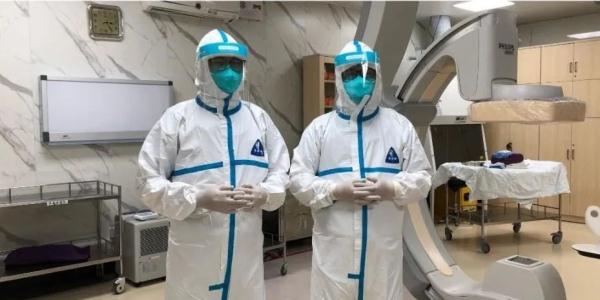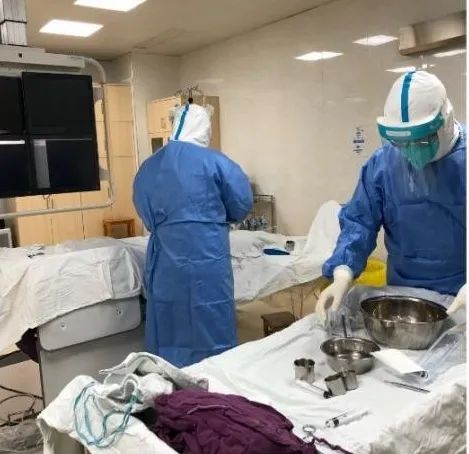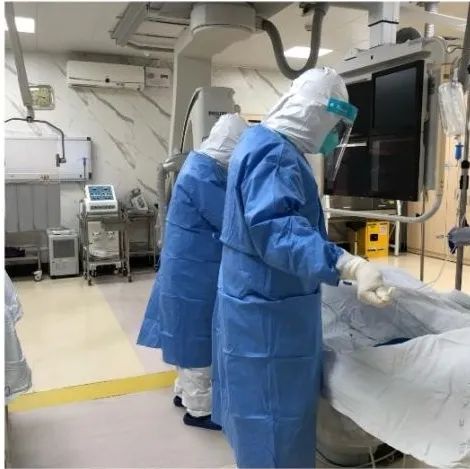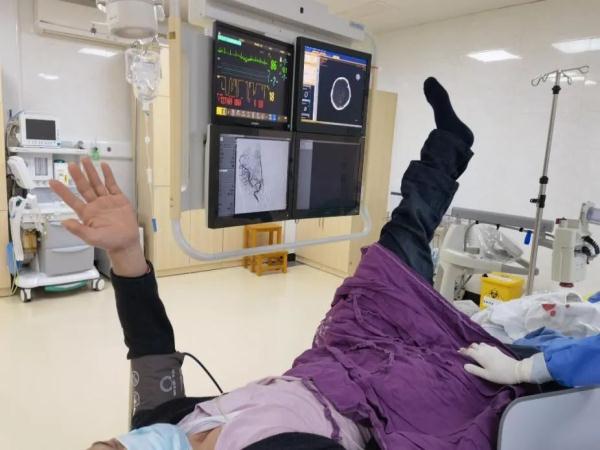A 48-year-old man had a stroke, had fever symptoms, and his nucleic acid was not detected. At a critical moment …
Recently,
48-year-old Guangzhou citizen
Mr. Li (pseudonym) suffered from a sudden stroke.
Go to the Stroke Center of Sun Yat-sen Memorial Hospital of Sun Yat-sen University for medical treatment.
however
He has fever,
And Covid-19 nucleic acid detection is not carry out,
What should we do?
Time is the brain, and time is life. "According to the suspected COVID-19 patient, start the emergency green channel for him!" After the medical staff of the intervention team of neurology department in the stroke center of this hospital collected nucleic acid on the spot, they immediately took three-level protective measures to implement emergency treatment for Mr. Li.
Guangzhou Daily Xinhua Flower City reporter learned from the hospital on April 15 that with the cooperation of emergency department, radiology department, interventional room, anesthesiology department and other departments, Mr. Li completed thrombolytic therapy in just 45 minutes and embolectomy in 90 minutes, quickly opening occluded blood vessels and finally turning the corner.
Start the emergency green channel
Complete thrombolysis and embolectomy within 90 minutes.
On the evening of March 31, Mr. Li suddenly felt weak in his left hand and foot, which lasted for 2 hours and still did not improve, so he came to Sun Yixian Memorial Hospital of Sun Yat-sen University for treatment. Because Mr. Li has fever symptoms and has not done nucleic acid testing, the fever clinic immediately took nucleic acid samples for him. Dr. Zhang Xiaoxu, a neurologist in the hospital, quickly identified it after receiving the treatment, judged it as an acute ischemic stroke, and immediately started the emergency green channel.
"The golden treatment time for ischemic stroke is usually only 3 hours to 4.5 hours. Mr. Li has been ill for 2 hours. The situation is critical and needs immediate treatment." Dr. Zhang Xiaotong said.
Since the results of Mr. Li’s nucleic acid have not yet come out, Dr. Zhang Xiaotong, together with the emergency department and radiology team, quickly completed the one-stop head CT plain scan, blood vessel and perfusion examination for him after taking three-level protection. The results showed that the right middle cerebral artery was occluded and the right hemisphere was hypoperfused, and the ischemic penumbra was quantified as 161.9 ml.
(Tmax>6s)。 If effective treatment is not taken in time, Mr. Li will face the possibility of permanent paralysis of his left limb.



The neurointerventional team in the hospital strictly followed the three-level protection required for epidemic prevention and control, quickly put on protective clothing, prepared various surgical instruments and equipment, and urgently performed bridging embolectomy.
Teamwork "bridging and taking bolts"
Hemiplegia disappeared after operation.
For stroke patients, "time is the brain and time is life!" In order to keep the patient’s brain function, after the examination results came out, Dr. Zhang Xiaoxu took intravenous thrombolysis for Mr. Li in the isolation ward, and then the nerve intervention team took the thrombus by relay bridging. With the cooperation of Deputy Chief Physician Yang Xinguang and Dr. Chenguang Li, the thrombus was taken by a single stent in just half an hour, which perfectly opened the occluded blood vessels and restored the effective blood flow of Mr. Li’s middle cerebral artery.
After the operation, Mr. Li’s left paralyzed limb can be lifted and moved freely on the operating table immediately. Two hours later, Mr. Li’s nucleic acid negative results came out and he was transferred to the neurology department for further observation and treatment. One week after the operation, Mr. Li recovered smoothly and was discharged from hospital.

After the operation, Mr. Li’s left paralyzed limb can be lifted immediately and move freely.
"In the special period of epidemic prevention and control, the treatment of stroke patients is still urgent, and it is necessary to ensure the smoothness of the emergency green channel." Professor Wang Yidong, director of the Department of Neurology and Cerebrovascular Diseases at Sun Yat-sen Memorial Hospital of Sun Yat-sen University, said that according to the hospital’s epidemic prevention and control requirements, the stroke center further improved the emergency stroke treatment process, and through multidisciplinary cooperation, a "race against time" stroke emergency treatment was successful, achieving both epidemic prevention and stroke treatment.
Know more d:
It is not enough to master "Stroke 120"
Be wary of these symptoms.
Professor Wang Yidong said that in recent years, "Stroke 120", a rapid method for Chinese people to identify stroke, has been well promoted: "1" stands for "seeing an asymmetric face"; "2" stands for "check whether there is unilateral weakness in both arms"; "0" stands for "Listen (zero) to see if the speech is clear". If the patient is suspected to have a stroke through these three steps, you can call the emergency number 120 immediately.
"In addition to these three common symptoms, sudden walking instability, decreased vision, and double vision may also be precursors of stroke, and everyone should also pay attention to it." Professor Wang Yidong reminded.
Professor Wang Yidong introduced that stroke is usually divided into two categories: ischemic and hemorrhagic, and its treatment effect has a strong time dependence. In response to ischemic stroke, the internationally recognized intravenous thrombolysis therapy is within 4.5 hours of onset. In China, some patients can also be treated with intravenous thrombolysis within 6 hours of onset. Arterial embolectomy can be performed within 24 hours of onset, but most patients are only suitable for arterial embolectomy within 6 hours of onset. Hemorrhagic stroke is usually serious, and many patients need early surgical treatment.
"If the treatment is carried out after the above onset time, the therapeutic effect of stroke will be significantly reduced, and the chances of disability and death will be greatly increased." Professor Wang Yidong reminded that once a stroke occurs, it is necessary to go to the nearest medical institution (usually a third-class hospital) with the corresponding stroke treatment ability as soon as possible to receive standardized treatment.
Text/Guangzhou Daily Xinhua City Reporter: Ren Shanshan Correspondent: Zhang Yang, Yang Xinguang, Wang Hongxuan
]